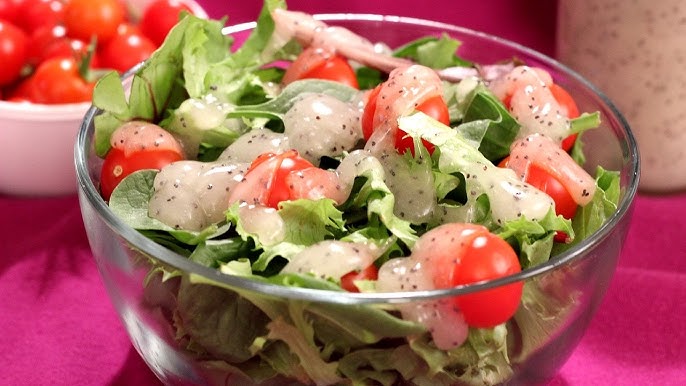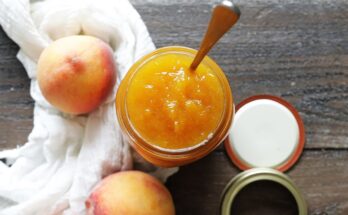Poppyseed Dressing Recipe: Poppyseed dressing is a delightful balance of sweet, tangy, and slightly nutty flavors that can instantly elevate any salad or dish. This classic dressing combines simple pantry ingredients into something truly special — a golden, speckled emulsion that looks as beautiful as it tastes. Whether drizzled over a fresh fruit salad, tossed with spinach and strawberries, or served with grilled chicken, this dressing never fails to impress.
It’s the kind of recipe you make once and then wonder why you ever bought it from the store. The homemade version tastes fresher, contains no preservatives, and allows you to control the sweetness and acidity to your preference. Plus, it takes less than 10 minutes to whip up!
Let’s dive into what makes this dressing so irresistible.
What Makes Poppyseed Dressing So Special?
What sets poppyseed dressing apart is its perfect flavor harmony. The sweetness from honey or sugar complements the tang of vinegar or lemon juice, while the tiny poppy seeds add a subtle crunch and beautiful visual appeal. It’s light yet flavorful, simple yet sophisticated.
Unlike heavy creamy dressings, poppyseed dressing feels refreshing and bright. It enhances the natural flavors of fresh produce without overpowering them. Its versatility also makes it a kitchen staple — it pairs just as well with leafy greens as it does with fruit or even roasted vegetables.
Perfect Pairings – What to Serve It With
Wondering where to use this luscious dressing? The possibilities are endless! Here are some delicious ideas:
- Spinach and Strawberry Salad: The sweet berries and crunchy almonds taste divine with the tangy dressing.
- Chicken and Poppyseed Pasta Salad: A light yet satisfying meal perfect for summer lunches.
- Fruit Salad: Add a drizzle of poppyseed dressing for an elegant twist.
- Grilled Vegetables: It brightens up charred veggies with a sweet-tart balance.
- Slaws and Wraps: A great way to upgrade simple cabbage slaw or chicken wraps.
No matter how you serve it, this dressing adds a gourmet touch to your meal.
Why You’ll Love This Homemade Poppyseed Dressing
Homemade poppyseed dressing is not just about taste—it’s about freshness, quality, and control. You know exactly what’s going into it, and you can tweak it to suit your preferences. Let’s explore a few reasons why this recipe deserves a permanent spot in your kitchen.
Healthier and Fresher Than Store-Bought Versions
Store-bought dressings often contain unnecessary additives, preservatives, and excess sugar. When you make it yourself, you’re in charge of the ingredients. You can use high-quality oils, natural sweeteners, and fresh vinegar or lemon juice to create a cleaner, healthier dressing.
Plus, homemade dressing doesn’t just taste better—it’s genuinely better for you. It’s fresh, preservative-free, and rich in healthy fats if you use oils like olive or avocado. You can even experiment with different sweeteners like maple syrup or agave for a more natural flavor.
Simple Ingredients, Big Flavor
The beauty of poppyseed dressing lies in its simplicity. You don’t need fancy ingredients or special equipment to make it. Most of what you need is probably already in your pantry. Despite its simplicity, the flavor payoff is remarkable.
Sweet, tart, and nutty all at once—it’s a dressing that makes even the simplest salad taste restaurant-quality. Whether you’re making it for a quick lunch or a special dinner, this dressing delivers every time.
Ingredients You’ll Need
Before diving into the step-by-step process, let’s take a closer look at the ingredients that make this dressing shine.
| Ingredient | Quantity | Purpose |
|---|---|---|
| Olive oil or vegetable oil | ½ cup | Base for the dressing |
| White wine vinegar or apple cider vinegar | ¼ cup | Adds tangy flavor |
| Honey or sugar | 2–3 tablespoons | Provides sweetness |
| Dijon mustard | 1 teaspoon | Enhances flavor and helps emulsify |
| Poppy seeds | 1 tablespoon | Adds crunch and signature look |
| Salt | ¼ teaspoon | Balances flavors |
| Ground black pepper | A pinch | Adds mild heat |
| Optional: Lemon juice | 1 tablespoon | Brightens the dressing |
Optional Add-ins for Custom Flavor
Want to personalize your poppyseed dressing? Here are a few ways to make it uniquely yours:
- Creamy Texture: Add a tablespoon of Greek yogurt or mayonnaise.
- Extra Sweetness: Increase honey or use orange juice for a fruity touch.
- Citrus Twist: Replace vinegar with lemon or orange juice for a zesty pop.
- Herbal Hint: Add fresh herbs like basil or mint for a refreshing flavor.
These small tweaks can completely change the flavor profile, so feel free to experiment and make it your signature dressing.
Kitchen Tools Required
To make this recipe as simple as possible, you’ll only need a few basic kitchen tools.
- Measuring cups and spoons
- A small mixing bowl or jar
- A whisk (or a mason jar with a lid for shaking)
- A storage container or bottle
Substitutes for Missing Tools
Don’t have a whisk? No problem. You can shake all the ingredients together in a sealed jar until the mixture emulsifies beautifully. It’s quick, easy, and mess-free. If you don’t have a jar, even a blender or immersion blender will do the trick for an ultra-smooth texture.
Step-by-Step Guide to Making Poppyseed Dressing
Now that you have everything ready, let’s walk through the process step by step. It’s straightforward, quick, and requires no cooking—perfect for busy days.
FAQs about Poppyseed Dressing Recipe
1. How long does homemade poppyseed dressing last?
Homemade poppyseed dressing can last up to 10 days in the refrigerator if stored in an airtight glass jar. Always shake well before using and discard if you notice any off smells or changes in texture.
2. Can I make it vegan or dairy-free?
Yes! Simply use maple syrup or agave nectar instead of honey, and avoid adding any yogurt or mayo if you’re making a creamy version.
3. What’s the best oil to use?
Olive oil provides a rich flavor, while vegetable or avocado oil gives a more neutral taste. You can even mix both for a balanced flavor profile.
4. Can I freeze poppyseed dressing?
You can freeze it in small portions, but it’s best enjoyed fresh. If frozen, thaw it completely and whisk before using to restore texture.
5. How do I make it creamier?
For a creamier version, add 2 tablespoons of Greek yogurt, mayonnaise, or sour cream. This makes the dressing thicker and perfect for dips or coleslaw.
Tips for the Perfect Poppyseed Dressing
Crafting the perfect poppyseed dressing is all about striking the right balance between sweet and tangy flavors. Here are some expert tips to ensure your dressing turns out smooth, flavorful, and irresistible every single time.
Balancing Sweetness and Acidity
Getting that ideal sweet-tart balance can make or break your dressing. The general rule is a 2:1 ratio of oil to vinegar, with sweetness adjusted to taste. Start small—you can always add more honey or sugar, but you can’t take it away once it’s in!
For a brighter flavor, use lemon juice instead of vinegar, or add a splash of orange juice for a citrusy note. On the other hand, if you like your dressing tangier, opt for white wine vinegar or apple cider vinegar instead of balsamic or rice vinegar.
A good tip? Taste your dressing on the actual salad ingredients you plan to serve it with. Sometimes, fruits like strawberries or mandarins already add natural sweetness, so you might not need as much honey as the recipe calls for.
Getting the Right Consistency
Texture matters as much as taste. A good poppyseed dressing should be smooth and pourable—not too thick, not too runny. If it feels too heavy, whisk in a teaspoon or two of warm water to loosen it up. For a thicker, creamier texture, add a spoonful of Greek yogurt or a bit of mayonnaise.
If your dressing separates after refrigeration, don’t panic! This is normal for homemade dressings without artificial stabilizers. Simply let it sit at room temperature for 5–10 minutes, then shake or whisk until it comes back together.
Variations of Poppyseed Dressing
One of the best things about poppyseed dressing is its versatility. You can easily tweak it to create exciting variations that suit different dishes and preferences. Let’s look at some popular versions.
Honey Poppyseed Dressing
If you love natural sweetness, honey poppyseed dressing is for you. Simply replace sugar with honey for a richer, floral flavor. The honey also helps the dressing emulsify beautifully, creating a thick, velvety texture.
This version pairs exceptionally well with fruit-based salads like strawberry-spinach or peach-arugula. The combination of honey’s sweetness and vinegar’s tang brings out the natural flavors of fruits and greens alike.
Creamy Poppyseed Dressing
For a richer, more decadent dressing, try the creamy version. Add 2–3 tablespoons of mayonnaise, sour cream, or Greek yogurt to your base recipe. This transforms the dressing into something luxuriously smooth and slightly tangy, perfect for heartier salads or coleslaws.
The creamy version also makes a great dip for fresh vegetables or a spread for sandwiches and wraps. It’s versatile, comforting, and always a crowd-pleaser.
Lemon Poppyseed Dressing
Want a lighter, citrus-forward twist? Swap the vinegar for fresh lemon juice. The result is a vibrant, zesty dressing that brightens any dish it touches. Lemon poppyseed dressing is perfect for seafood salads, grilled chicken, or even drizzling over roasted asparagus.
The lemon enhances the flavor of the poppy seeds and adds an extra layer of freshness that’s hard to resist. If you want to get creative, try adding a touch of orange zest for a flavor explosion.
How to Store and Preserve Poppyseed Dressing
Proper storage ensures your homemade dressing stays flavorful and safe to consume. Since it’s made with natural ingredients and no preservatives, it needs to be stored with care.
Storage Tips and Shelf Life
Keep your dressing in an airtight glass jar or bottle. Store it in the refrigerator immediately after making it. Most vinaigrette-style dressings like this last up to 10 days when refrigerated. If you notice any separation, shake well before use.
Avoid exposing it to direct sunlight or keeping it on the counter for long periods, as this can cause the oil to turn rancid faster.
If you made a large batch, consider freezing small portions in ice cube trays. Once frozen, pop them out and store in a zip-lock bag. Thaw one cube at a time as needed—perfect for quick salads!
Signs Your Dressing Has Gone Bad
Homemade dressings are fresh but perishable. Watch for these signs of spoilage:
- A sour or unpleasant odor
- Change in color (darkening or cloudiness)
- Separation that doesn’t remix even after shaking
- Mold or residue around the lid
When in doubt, toss it out! It’s always better to make a fresh batch than risk consuming spoiled dressing.
Serving Suggestions
Poppyseed dressing is an all-purpose star in the kitchen—it pairs wonderfully with a variety of dishes, from refreshing fruit salads to hearty vegetable bowls. Its subtle sweetness and tang make it one of the most versatile dressings you can make at home. Here are some creative and delicious ways to serve it.
Best Salads for Poppyseed Dressing
- Spinach and Strawberry Salad: This is the classic pairing for poppyseed dressing. The sweetness of the strawberries, the crunch of almonds, and the tangy kick from the dressing create a perfect balance of flavors. Add some crumbled feta or goat cheese for an extra layer of creaminess.
- Mandarin Orange Chicken Salad: Toss fresh greens, grilled chicken, mandarin orange segments, and red onion together, then drizzle with poppyseed dressing. The sweet and citrusy flavors work beautifully with the savory chicken.
- Broccoli and Cauliflower Salad:
For a crunchy, veggie-packed salad, mix raw broccoli florets, cauliflower, red grapes, and sunflower seeds with creamy poppyseed dressing. It’s hearty, colorful, and perfect for potlucks or picnics. - Kale and Apple Salad: Thinly slice fresh apples, add some chopped pecans, and toss with baby kale. The dressing softens the kale while complementing the sweetness of the apples.
- Berry Mix Salad: Combine blueberries, raspberries, and blackberries with baby spinach or arugula, then drizzle on the dressing. It’s fresh, fruity, and simply irresistible.
Each of these salads becomes restaurant-quality with just a spoonful of this golden, speckled dressing.
Creative Ways to Use It Beyond Salads
Poppyseed dressing isn’t just for greens—it’s a flavor booster that can transform all sorts of dishes. Try these fun ideas:
- Marinade for Chicken or Fish: The sweet-tangy profile makes it an excellent marinade for grilled or baked chicken, salmon, or shrimp. Let your protein sit in the dressing for about 30 minutes before cooking to infuse it with flavor.
- Drizzle Over Roasted Vegetables: Add a touch of brightness to roasted carrots, beets, or sweet potatoes by drizzling poppyseed dressing over them right before serving.
- Dip for Fresh Fruit or Veggies: For a quick appetizer, serve it as a dip with apple slices, grapes, cucumbers, or bell peppers.
- Wraps and Sandwiches: Spread a thin layer on chicken wraps or turkey sandwiches to give them a sweet and tangy twist.
- Glaze for Baked Goods: Believe it or not, a sweetened version of this dressing (with extra honey and lemon) can even be brushed on baked goods like scones or muffins for a glossy finish.
The possibilities are endless—once you make this dressing, you’ll find new uses for it almost daily.
Nutritional Information
Poppyseed dressing might taste indulgent, but it can actually be quite healthy when made at home. Here’s a breakdown of what’s in a typical 2-tablespoon serving of homemade vinaigrette-style poppyseed dressing:
| Nutrient | Amount (approx.) | Health Benefit |
|---|---|---|
| Calories | 120–150 | Provides energy from healthy fats |
| Total Fat | 12–14g | Contains heart-healthy monounsaturated fats (if olive oil is used) |
| Carbohydrates | 5–6g | Natural sugars from honey or sugar |
| Protein | 0g | Minimal protein content |
| Fiber | 0.5g | From the poppy seeds |
| Sodium | 100–150mg | Moderate amount, depending on added salt |
| Vitamin E | Present | Supports skin and immune health |
Health Benefits:
- Poppy seeds are a source of calcium, magnesium, and fiber, adding a slight nutritional boost.
- Olive oil contributes healthy fats that help reduce inflammation and support heart health.
- Honey or natural sweeteners provide quick energy without refined sugars.
You can make the dressing even lighter by reducing the oil slightly or using Greek yogurt for a creamy, lower-calorie variation.
Common Mistakes to Avoid
Even though making poppyseed dressing is simple, a few common missteps can affect the final result. Here’s how to avoid them and ensure your dressing turns out perfectly every time.
Overpowering Flavors
The secret to a great dressing is balance. Using too much vinegar can make the dressing harsh and sour, while too much sweetener can make it taste like syrup. Always start small—taste as you go and adjust gradually.
Another common mistake is using too much mustard. While Dijon is essential for emulsification, adding more than a teaspoon or two can overwhelm the delicate sweetness of the dressing. Keep the proportions in check for a well-rounded flavor.
If your dressing turns out too strong, you can dilute it with a bit more oil or a splash of water to mellow it out.
Separation Issues and How to Fix Them
It’s normal for homemade dressings to separate after sitting for a while, but if yours separates too quickly, it may need a better emulsifier or more thorough mixing.
Here are a few solutions:
- Whisk Longer: The longer you whisk, the better the oil and vinegar combine.
- Add Dijon Mustard: It helps bind the ingredients naturally.
- Blend It: Using a blender or immersion blender ensures a stable emulsion that stays together longer.
- Shake Before Use: Always give your dressing a good shake before serving—it brings everything back together beautifully.
If stored properly, your dressing will stay smooth and delicious throughout the week.
Conclusion
Poppyseed dressing is a kitchen gem that brings together simplicity, flavor, and versatility. With just a handful of pantry ingredients and a few minutes of your time, you can create a dressing that elevates any dish—from a simple green salad to a vibrant fruit bowl.
Making it at home not only ensures freshness and quality but also gives you the freedom to adjust the sweetness, tang, and texture to your liking. Once you try this homemade version, you’ll never want to go back to store-bought again.
Whether you keep it classic, go creamy, or add a citrus twist, this poppyseed dressing will quickly become one of your favorite go-to recipes.



